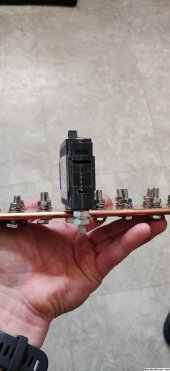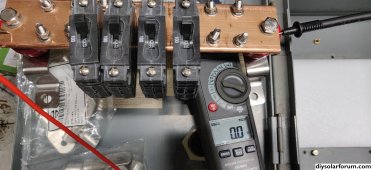ksmithaz1
Solar / EV Junkie
Mmmm, . . . I'm old, forgotten much of the old schooling, but my understanding of physics is that current flow is subject to the resistance of the surrounding material which is extremely low on a copper plate. This is how a shunt works. So if you have a 2 x 8 inch copper square significant current is flowing across the entire plate, even if the inputs and outputs are bolted closer together on one end. Partially to the point, there is resistance in the material which is why you want parallel battery cables to be as close in length as possible. The highest resistance is normally going to be around the connection points, so if you put the connections on either end you will still generate the most heat where it's bolted down. The center of a very long fat copper plate would likely to be close to ambient elevated only by the heat sink property of the metal around the resistance points. Technically moving the two connection points closer together will reduce the overall resistance, because you have a path thru less material, but the resistance in a chunk of copper is already so low I think it would be difficult to measure, and the electrons take all paths, proportional to the resistance of the surrounding material. At least that is how I remember it from school, happy to be enlightened otherwise.If you connect in the order Battery Battery Inverter Inverter, all current goes through busbar cross section.
Connected Battery Inverter Inverter Battery, no part of the busbar carries more than half the current.
I was able to put lugs on top and bottom of busbar.
My setup is [Inverter/Inverter] Battery [Inverter/Inverter] for negative.
Inverter/Inverter Fuse Battery Fuse Inverter/Inverter for positive
(Two short cables spread out from battery to two fuses, and two inverters connect to each fuse.)
Does look sexy and it's very clean to have real nice shiny copper plates, but from a practical standpoint just make sure you have a nice fat busbar with good tight connections. I'd go to 3/8 (10M), or at least 5/16" (8M) lugs on 4/0, copper or tin plated copper. Re-torque the connections after you've been running a week or two for paranoia, nut and split washer. I'd put a fuse/breaker on every wire transition. Example: Battery bus 4/0 300A fuse bus-bar 2x 2/0+150A breaker inverter. If you are DIY'ing the batteries directly to the bus make sure you have a breaker on the BMS or inline on the feed cable that matches the max expected current flow on that branch to/from the bus. Running the buses as described above makes it really clean to keep your connections straight, all the batteries on one edge, inverters on the other which will avoid confusion, and make the wiring easier when you are bending fat cable and bolting it down.




